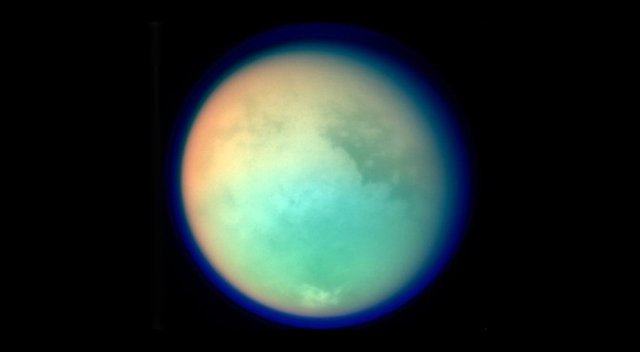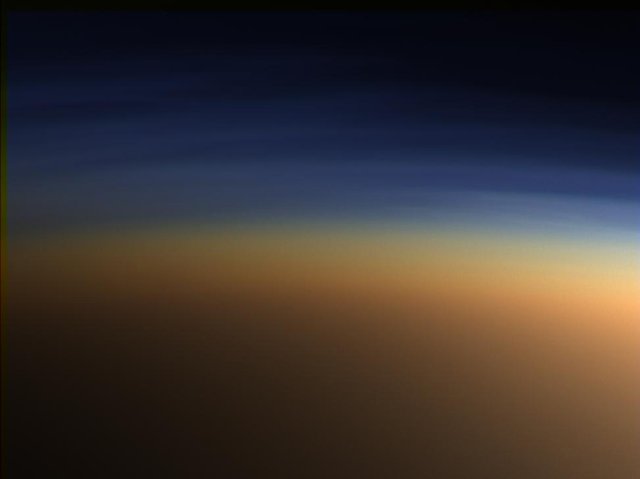Alien Life Possible on Saturn’s Moon Titan

For decades, scientists have believed that life on other planets can only exist if there is water, and the planet is in the “Goldilocks” zone. A planet is in the Goldilocks or habitable zone if it is the right distance away from their sun or star.
Saturn’s largest moon Titan is not in the habitable zone, but it does have a dense atmosphere. It is also the only object, other than Earth, that has stable bodies of surface liquid. With a radius of less than half that of Earth (1601 miles as opposed to 3959 miles), it is nevertheless considerably bigger than our moon which has a radius of 1079 miles.
These factors had scientist decide that Titan was worth exploring and on 25 December 2004, the Huygens atmospheric entry probe was launched to help in the investigation. Since its successful landing on Titan in 2005, a team of researchers at Cornell University have been simulating the conditions found in an effort to show that certain chemical reactions could lead to life forms, even if there is no water present. If this is the case, the theory of life only existing on planets in the Goldilocks zone will continue to lose credibility.

True-color image of layers of haze in Titan's atmosphere (Image Credits: NASA)[/caption]
The researchers reason that for life to come about in places not deemed viable by the traditional theories, some type of action needs to be going on. Titan has rainfall and erosion – both caused by liquid movement, exactly the action researches were looking for. The liquid in question is however not water. Ethane and methane rain has brought down hydrogen cyanide that has been found in Titan’s sediment. Although there is water on Titan, it is frozen solid and deep underground.
Once the data from Huygens uncovered these molecules, the researchers designed simulations, hoping that the reactions from these would form the basis of the creation of polyimine polymers. Huygens’ data has shown that polymers such as polyimine has already developed on Titan’s surface.
Once polymers are present, these can result in prebiotic reactions, which in turn leads to a form of life. The simulations done by the team Cornell University showed that not only are such reactions possible, but the structures that came about are able to absorb the wavelengths of the sunlight present on Titan’s surface.
The origin of life question has been around forever. Hydrogen cyanide’s (HCN) chemistry is central to current thinking on the subject. Measurements made by the Huygens probe have shown differences between the surface and the atmosphere of Titan. It is believed that HCN-based polymers have formed on the surface of the moon because of atmospheric chemistry. If this is the case, Titan has been identified as a valuable "natural laboratory", and can be used for exploring possible non-terrestrial types of prebiotic chemistry.
Polyimine (pI) has been identified as a polymer that is a major component in laboratory experiments involving polymerized HCN. Theoretical calculations have now been used to study the chain conformations of polyimine.
The polymer has a flexible backbone, which makes it possible for it to exist in several different polymorphs. These are relatively close in energy and both the structural and electronic variations amongst them is astounding. Over a 3-eV range, the band gap changes when it moves from a planar sheet-like structure to progressively more coiled conformations.
Titan's atmosphere has a window of relative transparency and this indicates that pI could be photo-chemically active. If this were the case, it would in turn drive chemistry on the moon’s surface. If catalysis or photochemistry is available to lower reaction barriers sufficiently, the dynamics for removing and adding HCN from pI is plausible.
Speculation suggests that pI's intra- and intermolecular hydrogen bonds’ directionality may drive the forming of ordered structures, albeit partial. Some of these structures may synergize with photon absorption and act as a catalyst.
The researchers are hoping that their work, and that done by others, will result in the sending of a next probe to Saturn’s moon. They suggest that this probe should have the ability to test for different forms of life. The design of future missions to Titan will be aided by studies on the density and solubility of the pI polymers.
The full study was published in PNAS journal.

Like what you read (without annoying ads :) ) ? Then please upvote our posts for more daily #science #news on #SteemIt
Mission impossible)
Interesting to read, but if I am not mistaken, there are other moons that scientists believe are more likely to host life, particularly around Jupiter. My thought is that life could exist just about anywhere, although it may not be life that we recognize. I'd bet that quite a few moons have microbial life.
Europa - indeed. But there's another Saturnian moon which is the most likely - Enceladus. It most likely has a subsurface ocean of liquid water which touches the rocky mantle! Of course, Mars is always a candidate for life.
I think I read something about Europa recently but not about Enceladus. If you have some links send them our way if not then we will do some digging on our own.
As for Mars, apart from the little grey men, I doubt there is life there. We could however bring life to it. And in a few decades already if all goes well ;)
If you have any links to your sources we would be glad to read them. Maybe there is another article there for us to write :)
Certainly! This is a pretty good article - http://www.scientificamerican.com/article/excitement-builds-for-the-possibility-of-life-on-enceladus/
Keep writing, by the way! I know right now the audience for science news will be small, but as Steemit grows, so will your audience.
Thank you!
No worries, we will keep on writing in any case :) We wouldn't mind if a whale upvotes us, but if they don't it also won't be a problem. This is our passion project :)
You have made some decent points there. I looked on the web for more info about the issue and found most individuals will go along with your views on this steem profile
Thank you, you have been downvoted kind bot.
"kind bot" - Love you :-*
Hi! This post has a Flesch-Kincaid grade level of 11.0 and reading ease of 51%. This puts the writing level on par with Michael Crichton and Mitt Romney.
You kind bot was fun to read the first time, but not so much anymore. Downvoted and will do so in all future instances of you posting under our posts.